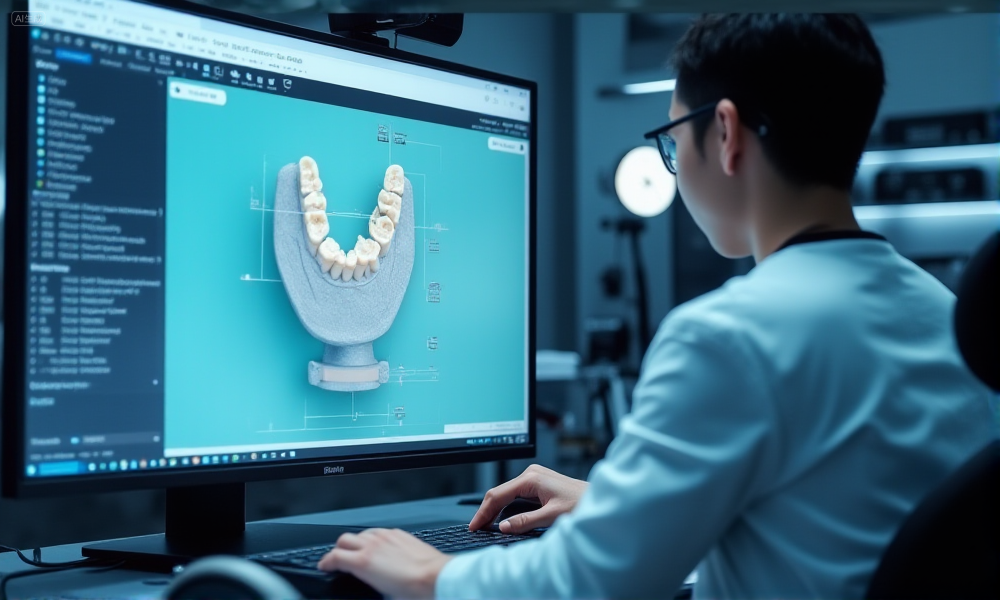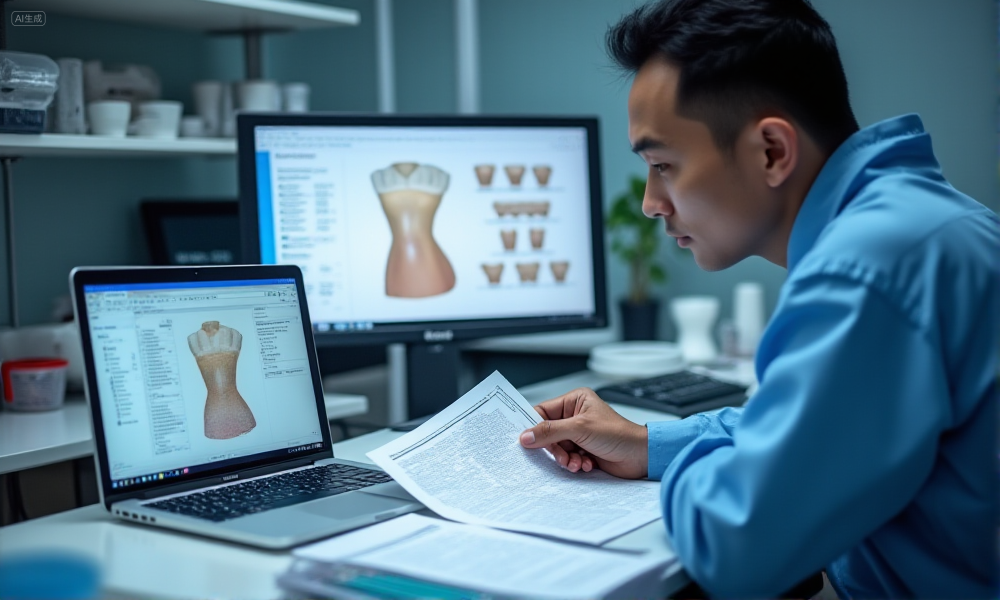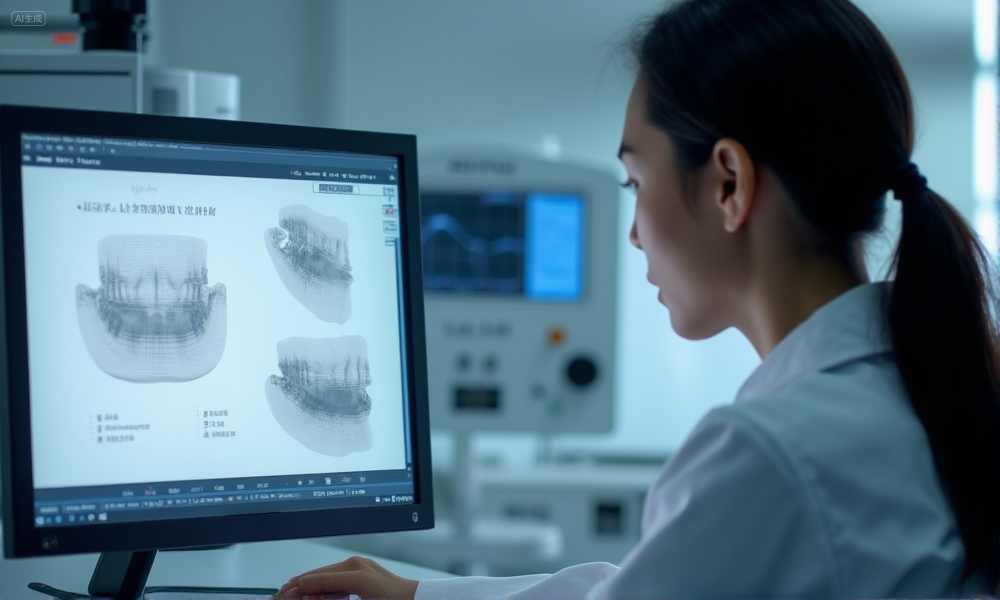Effective coordination with overseas dental labs for implant restorations relies on establishing reliable communication systems and clear case support workflows. Dental procurement teams and practices that outsource implant restorations need to ensure that every stage—from the initial digital case submission to final delivery—is precise, consistent, and timely.
The most impactful areas to manage include:
- Clear communication channels – Define dedicated contact points, use real-time collaboration tools like case portals or secure messaging, and schedule regular updates to prevent misunderstandings.
- Complete case information – Share accurate digital impressions, detailed restoration specifications, and occlusion data to minimize errors and production delays.
- Digital implant workflow integration – Utilize CAD/CAM design, 3D printing, and secure cloud-based platforms to streamline processes, enhance accuracy, and improve turnaround times.
- Proactive issue management – Identify and address potential complications early, maintain a documented change log, and keep all parties informed in real time.
- Quality assurance and consistency – Apply rigorous QA checks, conduct periodic process audits, and maintain structured feedback loops to ensure ongoing reliability.
- Collaboration efficiency tracking – Measure KPIs such as turnaround time, response speed, and issue resolution rate, refining workflows through regular performance reviews.
By focusing on these key operational factors, dental teams can build stronger partnerships with overseas dental labs, reduce operational risks, and maintain predictable, high-quality delivery schedules for implant restoration cases.
How to Establish Clear Communication Channels with Overseas Labs to Avoid Delays?
Clear communication with an overseas dental lab starts with defining exactly how information will be exchanged before the first case begins. Agreeing on platforms, response expectations, and escalation points prevents delays caused by missed messages or misunderstood requirements. Many successful collaborations treat this as part of the onboarding process, ensuring that both the clinic and the lab know when and how updates will be delivered, especially when working across time zones.

overseas-dental-lab-digital-collaboration
What Are the Best Digital Collaboration Tools for Real-Time Updates? (portals, video calls, messaging apps)
Choosing the right tools balances speed, security, and ease of use.
- Case Management Portals: Platforms like 3Shape Communicate or dedicated OEM portals allow secure upload of STL files, images, and instructions.
- Video Conferencing: Applications such as Zoom or Microsoft Teams help clarify margin designs, emergence profiles, or shade discrepancies in real time.
- Messaging Apps: For quick clarifications, encrypted tools like WhatsApp Business or WeChat (when agreed upon) ensure instant access to case updates.
When possible, integrate these tools into your lab’s standard workflow to avoid switching platforms mid-case.
Why Is It Important to Assign Dedicated Contact Persons for Streamlining Information Flow?
Having a single point of contact at both the clinic and the lab reduces confusion.
- Consistent Messaging – All case details are filtered through one person, avoiding conflicting instructions.
- Faster Resolution – The contact can make quick decisions or escalate issues without delay.
- Relationship Building – Over time, the contact learns preferences, reducing rework from misinterpretation.
From an overseas dental lab perspective, this role often bridges technical language gaps and ensures feedback is implemented correctly.
How Can Regular Check-Ins Help Keep Projects on Track Across Time Zones?
Scheduled meetings keep both parties aligned despite the time difference.
- Weekly Progress Calls: Quick updates on current cases, clarifying any pending approvals.
- Milestone Reviews: Align before critical steps, such as milling or staining, to avoid last-minute changes.
- Flexible Scheduling: Rotate meeting times if one party consistently works outside normal hours.
This regular rhythm minimizes misunderstandings and helps spot delays before they affect shipping timelines.
What Should Be Documented to Maintain Clear Records of Communications and Approvals?
Documentation is your safety net in complex implant restoration workflows.
| Record Type | Purpose | Example Content |
|---|---|---|
| Case Submission Form | Ensures all specifications are complete | STL files, shade tabs, occlusion notes |
| Change Log | Tracks modifications | Date, description, reason, approval initials |
| Approval Sign-Off | Confirms readiness for next step | Digital signature after design approval |
Consistent records not only protect both sides in disputes but also serve as references for future cases with similar requirements.
Strong communication foundations do more than prevent errors—they create trust. As an overseas dental lab partner, we have seen clinics cut turnaround times by up to 20% simply by formalizing communication routines and keeping channels open.For labs that follow ISO 13485 quality management systems or maintain recognized dental lab certifications, clear documentation also supports compliance and audit readiness.
What Information Should Be Included for Comprehensive and Accurate Case Submission?
A complete and accurate case submission is the foundation of a smooth implant restoration workflow with an overseas dental lab. The more precise and structured the information, the fewer clarifications are needed, and the faster the turnaround. Incomplete or unclear submissions often lead to design revisions, production delays, or misaligned expectations between clinic and lab.

dental-lab-case-submission-checklist
What Patient Details and Restoration Specifications Should Be Shared with the Lab?
A structured case file ensures every department in the lab works with the same reference.
- Patient Identifier: Unique case number (no full patient names for privacy).
- Implant System & Size: Brand, platform size, and angulation details.
- Restoration Type: Crown, bridge, hybrid denture, or other.
- Shade & Staining Instructions: Reference to specific shade tabs and custom characterization.
- Occlusion Records: Bite registration, opposing arch models, and functional movement notes.
From a global dental lab perspective, receiving all these elements upfront reduces back-and-forth and keeps milling schedules on track.
How Do Material Choices, Shade Selection, and Occlusion Data Impact Implant Restorations?
Material choice influences both the technical process and patient satisfaction. Zirconia offers durability and esthetics, but requires accurate occlusal clearance data. Titanium abutments provide strength but must be matched precisely to implant interfaces. Shade selection affects layering techniques, while occlusion records ensure the final prosthesis integrates seamlessly with the patient’s bite. Missing or inconsistent data in any of these areas can trigger remakes, adding days or weeks to the timeline.
Why Are High-Quality Digital Impressions Crucial for Fit and Precision?
Digital impressions eliminate many errors inherent in analog impressions, but only when captured correctly.
- Scanner Calibration: Regular calibration ensures accuracy of margin lines and emergence profiles.
- Moisture Control: Saliva or blood can distort scan data, especially around subgingival margins.
- Full Arch Capture: Ensures occlusal harmony, especially in multi-unit cases.
Labs working with properly captured STL files report fewer adjustments during seating and fewer cases returned for rework.
What Are Common Information Gaps That Lead to Production Delays?
| Missing Information | Impact | Preventive Action |
|---|---|---|
| Implant platform details | Wrong abutment design | Include brand + platform size in submission |
| Opposing arch data | Occlusal interference | Capture and send opposing arch scans |
| Shade tab reference | Mismatched color | Provide tab code and photo under neutral light |
| Approval for design changes | Idle production time | Set maximum response time for approvals |
An accurate case submission is more than a checklist—it’s a collaboration tool. As a global dental lab partner, we’ve seen clinics cut their remake rate by half simply by standardizing submission templates and ensuring all key details are included from the start.
How Can Digital Technology Speed Up Workflows and Reduce Errors in Implant Restorations?
Digital technology streamlines implant restoration workflows by replacing manual steps with precise, automated processes. When properly integrated, it reduces communication gaps, speeds up case handling, and minimizes the potential for human error. Overseas dental labs that embrace these tools often deliver faster turnaround times and more consistent quality.

Image
ALT: dental-lab-digital-implant-workflow
Prompt: A highly realistic, ultra-detailed, professional-quality photo captured in a clean, well-lit dental lab environment. Materials must be photorealistic, anatomically accurate, and rendered with DSLR-level clarity. Lighting should be soft daylight or studio white light, avoiding cold or bluish clinical tones. A Chinese dental technician is operating a CAD workstation, reviewing a 3D implant restoration design with occlusal adjustments highlighted, while a milling machine is visible in the background.
How Can Intraoral Scanners Ensure Precise Digital Impressions?
Digital impressions taken with intraoral scanners eliminate distortions from impression materials and shipping.
- Immediate File Transfer: STL files can be sent instantly to the lab, reducing transit delays.
- Margin Accuracy: High-resolution scanning captures fine details at the gingival margin for a better fit.
- Reduced Chair Time: Patients spend less time in the chair, and clinicians can rescan problem areas immediately.
When scanners are calibrated and used correctly, the lab receives data accurate enough to reduce adjustment visits.
Why Is CAD/CAM Design and Milling Critical to Speeding Up Production?
CAD/CAM technology links design directly to manufacturing, removing multiple manual steps. Once the restoration design is finalized in CAD software, it is sent directly to milling units or 3D printers. This integration shortens production timelines, reduces transcription errors, and allows for complex geometries that would be difficult to achieve manually. In an overseas dental lab setting, it also enables night-shift production that aligns with the client’s time zone, effectively “working while you sleep.”
How Can 3D Printing Be Used for Surgical Guides and Temporary Restorations?
3D printing creates precise, case-specific tools and temporaries in hours rather than days.
- Surgical Guides: Printed directly from digital implant planning software for accurate implant placement.
- Temporary Restorations: Fabricated quickly for patient comfort during healing.
- Reduced Manual Labor: Automates complex shaping, freeing technicians for higher-value tasks.
This capability is particularly valuable when the clinical team needs a rapid turnaround before surgery.
What Role Do Cloud-Based Platforms Play in Secure File Sharing and Version Control?
| Feature | Benefit | Example |
|---|---|---|
| Secure Storage | Protects patient data | Encrypted cloud storage compliant with HIPAA/GDPR |
| Version Tracking | Ensures latest file is used | Automatic version logs for STL/CAD files |
| Shared Access | Improves collaboration | Multi-user access for dentist, lab, and designer |
By centralizing files, these platforms ensure both parties are always working on the latest approved version, reducing rework from outdated designs.
Adopting digital tools is not just about technology—it’s about workflow transformation. As an overseas dental lab, we have seen clinics cut their delivery cycles by up to 30% simply by integrating scanners, CAD/CAM, 3D printing, and secure cloud sharing into a single connected process.
How Can Potential Issues Be Addressed Proactively to Avoid Delays?
Preventing delays in implant restoration cases is not just about solving problems quickly—it’s about anticipating them before they impact production. By setting clear protocols, maintaining transparent communication, and tracking all changes, clinics and overseas dental labs can work in sync to keep projects on schedule.

dental-lab-issue-prevention-protocol
What Protocols Can Be Set for Early Identification of Design or Fabrication Problems?
- Pre-Production Review: A technician checks digital designs for margin clarity, occlusion, and implant interface compatibility before milling begins.
- Red Flag Criteria: Establish measurable triggers for review—e.g., unclear emergence profile, insufficient occlusal clearance, or missing shade data.
- Test Fit on Model: For complex multi-unit cases, perform a printed model verification before final production.
- Cross-Team Sign-Off: Ensure both design and QC teams confirm readiness before moving forward.
These proactive checks catch most issues at the digital stage, where fixes are faster and less costly.
How Should Changes or Concerns Be Communicated to Prevent Timeline Disruptions?
When changes are needed, timing and clarity are critical. Instead of sending casual messages that can be missed, use the agreed communication channel with a clear subject line, case number, and change summary. Provide visuals—such as annotated screenshots—so the receiving team understands exactly what to modify. In an overseas dental lab partnership, setting an agreed maximum response time for change approvals ensures cases do not stall while waiting for confirmation.
Why Is Documenting All Revisions Important for Aligning Records Between Both Parties?
| Documentation Type | Purpose | Best Practice |
|---|---|---|
| Revision Log | Tracks all modifications | Include date, description, and initials of both parties |
| Annotated Files | Shows visual changes | Store alongside the original file in shared drive |
| Approval Record | Confirms agreement | Digital signature or email confirmation before next stage |
Without this documentation, it’s easy for misunderstandings to arise, especially when multiple revisions occur across time zones.
Proactive issue management is a shared responsibility. As a Chinese dental lab working with international partners, we’ve seen that a culture of early detection and clear documentation not only saves days in the schedule but also builds trust for long-term collaboration.
How Can Quality and Consistency Be Ensured in Collaboration with Overseas Labs?
Maintaining consistent quality in implant restorations is the result of well-defined QA standards, regular process checks, and open feedback between the clinic and the lab. Overseas partnerships require a clear quality framework to ensure every shipment meets the same technical and esthetic expectations.

dental-lab-quality-control-process
What QA Measures Should Be Implemented to Verify Restoration Quality Before Shipping?
- Dimensional Checks: Verify margin fit, emergence profile, and occlusal contacts using physical models or digital verification tools.
- Material Integrity: Inspect for micro-fractures, porosity, or shade inconsistencies under calibrated lighting.
- Functional Testing: For screw-retained restorations, check torque compatibility and screw access positioning.
- Photographic Documentation: Capture final images of the restoration for client approval before dispatch.
These steps create an objective record of quality and reduce disputes over finished work.
How Can Periodic Process Audits Improve Collaboration with the Overseas Lab?
Audits help identify systemic issues before they impact multiple cases. Clinics can request quarterly reviews where the lab shares production metrics such as average turnaround time, remake rates, and common adjustment reasons. From an overseas dental lab perspective, these sessions often uncover opportunities to adjust digital workflows, update materials, or retrain staff. This transparency ensures the partnership is evolving, not just maintaining the status quo.
How Can Feedback Loops Be Created to Improve Long-Term Collaboration Efficiency?
- Case Outcome Reports: Share seating results and patient feedback to refine future cases.
- Structured Review Forms: Use standardized scoring for fit, shade match, and turnaround.
- Collaborative Troubleshooting: When an issue occurs, both teams document the cause and resolution for reference.
Continuous feedback transforms isolated problem-solving into a growing knowledge base that benefits all future restorations.
Consistent quality is not achieved by inspection alone—it comes from a culture of shared standards and mutual accountability. As a global dental lab, we’ve found that clients who engage in structured QA and feedback cycles enjoy fewer remakes and more predictable outcomes over time.
How Can Communication Efficiency Be Measured and Improved for Implant Restoration Cases?
Measuring communication efficiency in implant restoration projects ensures both the clinic and the overseas dental lab stay aligned. By tracking key metrics, conducting regular reviews, and scaling proven methods, teams can reduce delays and improve case outcomes.

dental-lab-communication-efficiency-metrics
What KPIs Should Be Used to Track Turnaround Time, Response Rates, and Issue Resolution?
- Average Turnaround Time (TAT): From case submission to shipment, segmented by restoration type.
- Response Time: Hours between message sent and reply received, critical for time-sensitive clarifications.
- Issue Resolution Time: How long it takes to resolve a design or fabrication concern once identified.
- Remake Rate: Percentage of cases requiring rework due to communication-related errors.
Tracking these KPIs provides objective insight into workflow bottlenecks and helps both parties set realistic improvement targets.
How Can Review Meetings Help Refine Communication Workflows?
Regular review meetings create a forum for feedback and process adjustments. Instead of only discussing active cases, these sessions should analyze recent metrics, identify recurring bottlenecks, and agree on action items. From an overseas dental lab perspective, this also allows us to share updates on new tools, such as upgraded portals or template changes, that can further streamline communication.
How Can Best Practices Be Scaled Across Multiple Implant Restoration Cases?
- Standardized Case Submission Templates: Ensure every case starts with the same data set and format.
- Shared SOP Documents: Keep all process guidelines in a central, accessible location.
- Cross-Training Teams: Ensure more than one contact person can handle communications, preventing delays during absences.
Scaling proven workflows creates consistency, which in turn makes communication more predictable and less dependent on individual habits.
Measuring and improving communication efficiency is an ongoing process. As a global dental lab partner, we’ve seen that clinics using KPI tracking and structured reviews not only reduce turnaround times but also increase case acceptance rates over time.
Conclusion
Successful implant restoration partnerships with overseas dental labs rely on structured communication, complete case submissions, and the smart use of digital technology. By aligning on clear protocols, measuring performance with agreed KPIs, and maintaining consistent quality standards, clinics can achieve predictable results and shorter turnaround times. As an overseas dental lab, we understand that our role is to support, adapt, and deliver with precision, ensuring every restoration meets both clinical requirements and patient expectations. When both sides commit to proactive collaboration, efficiency and trust naturally follow—turning each project into a repeatable success.


